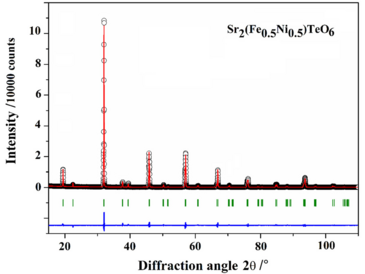Asmaa Zaraq, Duncan H. Gregory, Brahim Orayech, Josu M. Igartua,Abdeslam El Bouari,James D. Eales, Paul A. Binghamand Thorsten M. Gesing
Dalton Transactions (2022)
https://doi.org/10.1039/D2DT02447K
The double-perovskite series, Sr2(Fe1−xNix)TeO6 (x = 0, 0.25, 0.50, 0.75, and 1) has been synthesized in polycrystalline form by solid-state reaction at 1300 K in air. Their crystal structures were probed by powder X-ray diffraction at room temperature. Rietveld analysis revealed that all samples crystallize in the monoclinic space group I2/m. The double-perovskite structures ideally contain two alternating types of octahedra (Fe/Ni)2dO6 and (Te)2aO6, tilted in the system (a−a−c0). However, the refinements have shown a complex distribution of all three cations over the two available octahedral sites; 2d (½, ½, 0) and 2a (0, 0, 0). Raman spectroscopy further complements the obtained results, by revealing a tiny increase of the wavenumber of some Raman modes when Fe is substituted by Ni. The optical characteristics of the series were determined by fitting diffuse reflectance UV/Vis spectra enabling the optical band gaps to be derived from Tauc method and derivation of absorption spectra fitting (DASF) techniques. Analyses of the obtained 57Fe Mössbauer hyperfine parameters at room temperature of samples with compositions x = 0, 0.25, 0.50 and 0.75 reveal the presence of Fe3+ in high-spin state with an anti-site disorder of Fe–Ni–Te cations in distorted octahedral environments (site 2d and 2a). The results show that significant correlations exist between the crystal structures and physical properties of double perovskites containing B site transition elements of different charge and size. Temperature-dependent magnetic susceptibility data show magnetic transitions below 40(1) K (38(1) K, 31(1) K, 25(1) K, 20(1) K, and 35(1) K for x = 0, 0.25, 0.50, 0.75, and 1, respectively. A divergence between FC and ZFC curves for all compositions has been observed. The results show that the ground states of the doped materials might be spin glasses or magnetically ordered.


